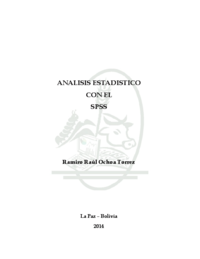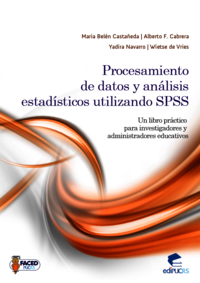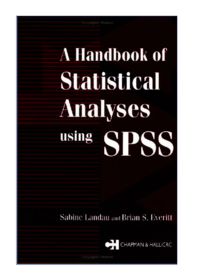Etiqueta "análisis estadístico"
Se han encontrado 3 Coincidencias
Análisis estadístico con el SPSS
128 Visitas | 158 Descargas | 2016-08-26 13:03:20 | alejandromorales
Guía práctica de trabajo con SPSS que cubre los temas de trabajo con las variables, distribución de frecuencias, medidas de tendencia central, dispersión y forma, prueba de T-Student, Chi cuadrado, análisis de varianza, regresión, correlación y determinación simple, diseños DCA y DBCA

Procesamiento de datos y análisis estadísticos utilizando SPSS
129 Visitas | 188 Descargas | 2016-08-26 13:09:20 | alejandromorales
El propósito de este libro consiste en familiarizar al lector con el uso del 1programa SPSS (Statistical Package for the Social Sciences) para Windows, de modo que pueda experimentar y realizar análisis adecuados para la investigación educativa con diversas técnicas estadísticas. La organización de los apartados facilita el autoaprendizaje. Además, para fines prácticos, los autores han optado por incluir en el texto tanto los términos españoles como los ingleses, ya que distintos usuarios pueden tener una versión en cualquiera de estos dos idiomas.

A Handbook of Statistical Analyses using SPSS
70 Visitas | 76 Descargas | 2016-08-26 13:17:25 | alejandromorales
SPSS, standing for Statistical Package for the Social Sciences, is a powerful, user-friendly software package for the manipulation and statistical analysis of data. The package is particularly useful for students and researchers in psychology, sociology, psychiatry, and other behavioral sciences, contain- ing as it does an extensive range of both univariate and multivariate procedures much used in these disciplines. Our aim in this handbook is to give brief and straightforward descriptions of how to conduct a range of statistical analyses using the latest version of SPSS, SPSS 11. Each chapter deals with a different type of analytical procedure applied to one or more data sets primarily (although not exclusively) from the social and behav- ioral areas. Although we concentrate largely on how to use SPSS to get results and on how to correctly interpret these results, the basic theoretical background of many of the techniques used is also described in separate boxes. When more advanced procedures are used, readers are referred to other sources for details. Many of the boxes contain a few mathematical formulae, but by separating this material from the body of the text, we hope that even readers who have limited mathematical background will still be able to undertake appropriate analyses of their data.
Contribuir
Usted puede contribuir con Libros UCLV, es importante para nosotros su aporte..
Contribuir